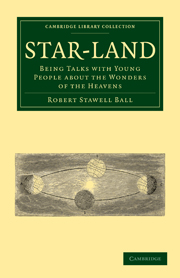LECTURE III - THE INNER PLANETS
Published online by Cambridge University Press: 01 June 2011
Summary
MERCURY, VENUS, AND MARS
We can hardly think of either the sun or the moon as a world in the sense in which our earth is a world, but there are some bodies called planets which seem more like worlds, and it is about them that we are now going to talk. Besides our Earth there are seven planets of considerable size, and a whole host of insignificant little ones. These planets are like ours in a good many respects. One of them, Venus, is about the same size as this earth; but the two others, Mercury and Mars, are a good deal smaller. There are also some planets very much larger than any of these, namely, Jupiter, Saturn, Uranus, and Neptune. We shall in this lecture chiefly discuss three bodies, namely, Mercury, Venus, and Mars, which, with the earth, form the group of “inner” planets.
The planets are all members of the great family dependent on the sun. Venus and the earth may be considered the pair of twins, alike in size and in the duration of their day. Mercury and Mars are the babies of the system. The big brothers are Jupiter and Saturn. All the planets revolve around the sun, and derive their light and their heat from his beams. We should like to get a little closer to some of our fellow-planets, and learn their actual geography.
- Type
- Chapter
- Information
- Star-LandBeing Talks with Young People about the Wonders of the Heavens, pp. 126 - 197Publisher: Cambridge University PressPrint publication year: 2010First published in: 1889



